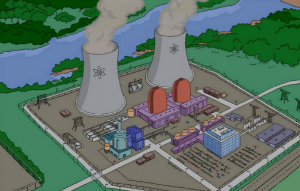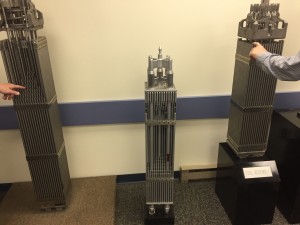
http://www.taringa.net/posts/imagenes/19306804/10-centrales-electricas-que-mas-contaminan-de-Europa.html
It has often been stated that the true purpose behind nuclear power is benevolence. Much like Alfred Nobel using his profits from the invention of dynamite to fund the internationally sought after Nobel Prize, governments have purported to reuse wartime weapons tech as a means of generating electricity which initially was hailed as a method that would soon become too cheap to monitor for residential consumption. Today there are 442 Nuclear Reactors in the world, their nationalities displayed on this page (euronuclear.org). It is clearly shown that the United states leads the world in number of reactors, at 99 nationwide, this is not surprising given that it was the US that first developed the atomic bomb, spawning a new era of “atomic culture”, from lunch boxes, to board games, to power plants, the evolution in nuclear power was accepted as a cultural revolution. It was only a few years prior to the TMI incident that the progressive, environmentalists began to call into question its lasting effects. We see that this is hauntingly apparent with the case of “The China Syndrome”, a film in which a pair of rogue journalists and nuclear physicists attempt to expose the criminally greedy and negligent actions of the corporate owners of a power plant. The movie ends (spoilers) with the rogue physicist being shot dead and a total meltdown at the plant being narrowly avoided, to the denial by the plants operators. Three Mile Island experienced a partial meltdown a few days after the film premiered. Yet today, as global warming paints a more and more gruesome picture, environmentalists (particularly in the USA) increasingly favor nuclear power as a carbon neutral energy source, recommending its use over coal and oil.

A model of the nuclear fuel (enriched uranium pellets) used to power reactors like the one at the Three Mile Island facility.
Such is the culture surrounding nuclear power today. There is much more that can be said of the cultural and political forces that establish and destroy nuclear power plants in the US and Japan. But first let us take a look at how the plants operate. This page provides a basic diagram of the processes involved in nuclear power. Like just about any other reactor, Nuclear produces energy by heating up water into steam, which turns a turbine, which powers a dynamo. The difference between nuclear and all other generators is that instead of burning the fuel, fission is conducted which splits the ultra heavy Uranium-235 nuclei into smaller atoms, a reaction which produces massive amounts of energy. The danger associated with this process is two fold. Firstly, a nuclear power plant cannot simply be shut down. The zirconium fuel rods containing the uranium must constantly be kept cool by circulating cold water over the fuel rods to prevent the uranium melting through the zirconium casing, which would produce highly pressurized, highly combustible hydrogen gas and could result in the reactor exploding, as seen at Fukushima in this video. The other danger is in the spent fuel rods. The radioactive waste produced by nuclear fission energy production is expected to remain radioactive until long after humans have become extinct, being there is no known process for stabilizing the waste. So the best that can be done is to store it, leaving it in a cooling pond for a few years, encasing it in concrete, then burying it deep underground. Except that no-one wants it buried within one thousand miles of their home. So it sits in pools next to the parking lot of the nuclear reactor. Leaving it susceptible to a massive hydrogen gas explosion.

The International Nuclear Event Scale is used to gauge the severity of nuclear disasters. Photo courtesy of Vinçotte Nuclear Safety. <http://www.avn.be/doc.php?nd=158&tid=58&site=1&lg=1&deploy=0>
Touring the nuclear reactor at Three Mile Island, we are assured of the reactors safety long before we have a chance to ask. We are told of hectic drills, intensive and regular training, and cautionary practices enacted for potentially dangerous weather conditions. We are told that the control room operators slept in their offices through the weekend of The Great Blizzard of 2016. Not that there was ever any cause for concern, of course. Any maintenance undertaken is submitted and approved months before taking place. Flat screens have been implemented alongside analog controls; sure the new plants have ditched analog tech entirely, but troubleshooting is much easier with analog. The post it notes, stuck over lights are just there to ensure there is no undue cause for alarm (nevermind Grandma Nazareth mentions them when she speaks deploringly of the 1979 TMI control room). I mention this experience, for which we had to submit our social security numbers and endure the inquiring glances of a paramilitary security force, to emphasize how confident these operators are in their safety and security, and how quick they are to dispel any notion that they aren’t. But it failed. Seemingly for no reason on a spring day 37 years ago, permanently shaking US confidence in nuclear power. The three point eleven event in Fukushima (as it is known by the locals) took a 9.0 earthquake and the resulting Tsunami, to bring four of over a dozen nuclear reactors on the west coast of Japan to their knees. They say that the diesel backup generators failed, which caused the reactor to overheat, which cause the fuel to melt through their containers, which caused a hydrogen gas bubble to form, which caused an explosion. Apparently though the reactors were built to withstand a tsunami, they couldn’t survive one this big. Our tour guide at TMI was very careful to show us the brand new, very highly placed, diesel backup generators inside the plant. Not that the Susquehanna River Valley is at risk for an earthquake, let alone a tsunami. The fact that the nuclear disaster was a result of once a millennium sized tsunami makes no difference to the people affected. All they know is that their homes are no longer safe. According to Tepco, their homes are worth nearly a fraction of what they were. According to doctors, their symptoms are psycho-somatic. And according to the government, many of them will be allowed to move in a few months from now. The government is eager to destroy the temporary housing units, which were only supposed to last five years, maximum.
Japan’s exceedingly high amount of seismic activity poses a continual threat to nuclear power plants across the nation. As Japan’s atomic energy plants are scattered around various areas of its islands, an earthquake could strike any one at any time. See a sample of the frequency of earthquakes in Japan here. Read about the 2011 Tohoku earthquake and tsunami that led to the Fukushima Daichi accident here and here. A tsunami of equivalent size to the one that struck in 2011 may not happen again for one thousand years. That makes 3.11 a once in a millennium occurrence. One thousand years ago was 750 years before the invention of electricity. It may be one thousand years from now nuclear fusion will be the only large scale method of electricity generation, and the human population has abandoned earth for another solar system. Yet we are hard pressed to find a single supporter of nuclear energy. Its understandable, people just see a disaster, and they think “never again”. But no-one thinks that the reactors won’t be reopened. Though Japan is a democracy, this is only one of many political issues people vote on when selecting a party or a candidate. And like in the US, people vote with their wallets, nuclear plants provide jobs, boost the economy, and provide electricity. It appears that the Japanese people will just have to get used to nuclear.
Click here to learn about the Three Mile Island accident and here to learn about the Fukushima Daichi disaster.